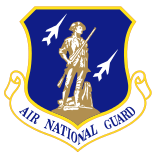223d Combat Communications Squadron
| 223rd Combat Communications Squadron | |
|---|---|
|
223rd Combat Communications Squadron emblem | |
| Active | 1953-2008 |
| Country | United States |
| Branch | United States Air Force |
| Type | Combat Communications |
| Role | Combat support |
| Part of | Air National Guard/254 CBCG |
| Garrison/HQ | [1] |
The United States Air Force's 223rd Combat Communications Squadron (223 CBCS) is an Air National Guard combat communications unit located at Hot Springs ANGS, Arkansas.
History
The 223rd began as the 8201st Air Base Squadron on 1 May 1952. The 8201st was discontinued on 30 November 1952 and became the 223rd radio Relay Squadron on 1 December 1952. With an authorized strength of four officers and 95 airmen, the 223rd had a mission to install and operate five radio relay stations and three radio terminals under field conditions. First Lt. Joe A. Holbrook became the Commanding Officer of the newly formed unit and held that position until March 1955. The unit was assigned to the Continental Air Command (CONAC), located at Selfridge AFB, Michigan.
Under Lt. Holbrook's command, recruiting took priority and the unit quadrupled in size within months. The unit's first exercise began on 5 July 1953, setting up a base station at the Garland County Municipal Airport and a second site at the Fairgrounds. There call signs were Zekeamoto Alpha and Zekeamoto Extra.
Captain George C. Bolton replaced Lt. Holbrook as commanding officer on 13 March 1955 and would hold that position until 1971. Lt. Holbrook's career with the 223rd was far from over. Through the years he was promoted to the rank of lieutenant colonel, but would later accept a demotion to the enlisted ranks with a rank of master sergeant so that he could remain in the unit. The respect that Joe Holbrook earned in his decades with the unit would earn him the nickname "Sergeant Colonel Holbrook", and his men would proudly admit they continued to call him "Sir" even after joining the enlisted ranks.
The 223rd was federally activated by President Dwight D. Eisenhower on 24 September 1957 to assist in the Little Rock Integration Crisis. During this time, a new building was under construction; the same building they would call home until the unit's closure in 2008. By 1960, the 223rd had gained recognition as a premier Radio Relay Squadron. The unit's manning increased to ten officers and 181 airmen, and they gained Food Services and Medical Services. The ongoing joke at the time was that introduction of both services at the same time was necessary, as you could not have a chow hall without having a medic.
In 1968, the unit's name changed to the 223rd Mobile Communications squadron, as they received Troposcatter radios, High Frequency (HF) radios, a Tactical Communications Center, Technical Control facilities, Tactical Switchboards and Cryptographic functions. Four months after receiving this equipment, virtually unseen by any member of the unit only months earlier, the 223rd took the Commanding Role in exercise Guard Strike 2.
The unit continued to grow, its inventory expanding and its members grasp of communications becoming sharper. By 1990, Lt. Col. Marc W. Barber, the former enlisted Air Advisor for the unit, became the commanding officer. His vision for the unit took it in new directions. After dozens of highly successful exercises and operations, the 223rd, now a Combat Communication Squadron, partnered with the C2TIG, or Command And Control Training and Integration Group at Hurlburt Field, Florida. This partnership led to the development of new eauipment, new missions and new ways of doing business; many of these new concepts were quickly adopted throughout the military and are standard practices today.
The decision to close the 223rd in 2008 was a financial one. The 189th Airlift Wing in Little Rock, Arkansas and the 188th Fighter Wing in Fort Smith gained many new personnel positions by this closure, as well additional equipment. During its history, over 4000 individuals signed the dotted line to become a member of the 223rd. Many came from active duty, representing all branches of the military, while many started and ended their careers with the unit.
Assignments
Major Command/Gaining Command
- Air National Guard/Air Combat Command (1992–2008)
- Air National Guard/Military Air Transport Service (1960–1992)
- Air National Guard/Continental Air Command (1952–1960)
Wing/Group
- 254th Combat Communications Group (1971 – present)
- 251st Combat Communications Group (1954–1971)
Previous designations
- 223rd Combat Communications Squadron (1976 – present)
- 223rd Mobile Communications Squadron (1968–1976)
- 223rd Radio Relay Squadron (1952–1968)
- 8201st Air Base Squadron (May - December 1952)
Bases stationed
- Hot Springs ANGS, Arkansas (???-Present)
Commanders
- Lt. Col. Philip Z. Horton (2000-)
- Lt. Col. Marc W. Barber (1990–2000)
- Major Ralph Van Cleve ( 1987–1990)
- Lt. Col. William E. Titus (1986–1987)
- Lt. Col. Ray E. Garner (1981–1986)
- Lt. Col. Alvin A. Albinson ( 1973–1981)
- Major Glen W. "Bill" Crone (1972–1973)
- Major Thomas G. Haggard (1971–1972)
- Lt. Col. George C. Bolton (1955–1971)
- Lt. Col. Joe A. Holbrook (1952–1955)
- Lt. Richard H. Scheibel (1952)
Decorations
References
"The Unofficial History of the 223rd" MSgt Scotty W. Welland (ret.) Published 2004


